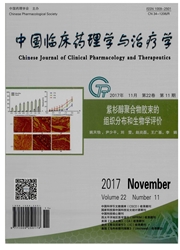

 中文摘要:
中文摘要:
目的:探讨硫化氢对糖尿病大鼠伤口肉芽组织血管形成的影响。方法:以健康雄性SD大鼠腹腔注射链脲佐菌素(STZ,65mg/kg)的方法建立糖尿病模型,72h后空腹血糖〉16.7mmol/L用作为糖尿病。1周后,于糖尿病大鼠背部剪切直径为2cm的圆形切口,随机将大鼠分为两组:糖尿病对照组(DC)和硫化氢处理组(HS)。在给药第5、10、15、20天测定伤口愈合率。21d后处死大鼠收集血样及肉芽组织,检测血浆血管内皮生长因子(VEGF)及细胞间黏附分子-1(ICAM-1);光镜观察肾组织形态改变,并对肉芽组织血管计数。结果:与DC组比较,硫化氢处理组糖尿病大鼠伤口愈合率明显加快(P〈0.05),血浆血管内皮生长因子及细胞间黏附分子-1水平明显提高(P〈0.05),组织学观察显示,对照组大鼠肉芽组织有炎症细胞浸润,胶原纤维排列疏松而不规则,硫化氢处理组大鼠肉芽组织胶原整齐,血管生成增多(P〈0.05)。结论:硫化氢可促进糖尿病大鼠伤口愈合,其机制可能与促进血管生成有关。
 英文摘要:
英文摘要:
AIM: To explore the effects of hydrogen sulfide on angiogenesis in wound from diabetic rats. METHODS: Diabetes is induced by a single injection of streptozotocin( STZ; in 0. 1 mol / L ice-cold citric acid-sodium citrate buffer,p H 4. 5)in healthy male SD rats. After 1 week,wound healing model was prepared by making a round incision( 2. 0 cm in diameter) at the dorsal regions of each rat in full thickness. Diabetic rats were randomly divided into 2 groups: diabetic control( DC); hydrogen sulfide treatment( HS). Wound healing was assessed by determining wound closure. Blood samples were collected for determination of vascular endothelial growth factor( VEGF),intercellular cell adhesion molecule-1( ICAM-1). Granulation tissues from the wound were processed for histological examination. RESULTS: Compared to diabetic control,hydrogen sulfide treatment significantly promoted the wound healing process by increasing rate of wound closure( P〈0. 05). A significant increase in levelsof VEGF and ICAM-1 was observed in diabetic rats treated with hydrogen sulfide( P〈0. 05). Histological observation indicated that hydrogen sulfide treatment significantly increased the number of capillaries( P〈0. 05) and improved the collagen synthesis.CONCLUSION: Hydrogen sulfide accelerates wound healing in diabetic rats,the beneficial effect of hydrogen sulfide may be associated with formation of granulation,and the increased level of vascular endothelial growth factor( VEGF).
 同期刊论文项目
同期刊论文项目
 同项目期刊论文
同项目期刊论文
 Morphologic features of Sancassania berlesei (Acari: Astigmata: Acaridae), a common mite of stored p
Morphologic features of Sancassania berlesei (Acari: Astigmata: Acaridae), a common mite of stored p Genetic diversity and differentiation of Lepidoglyphus destructor (Acari: Glycyphagidae) inferred fr
Genetic diversity and differentiation of Lepidoglyphus destructor (Acari: Glycyphagidae) inferred fr Production of a chimeric allergen derived from the major allergen group 1 of house dust mite species
Production of a chimeric allergen derived from the major allergen group 1 of house dust mite species 期刊信息
期刊信息
